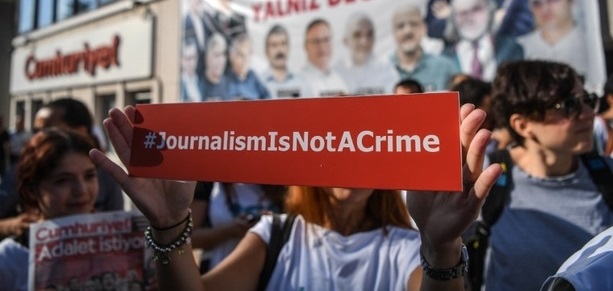
This week the government came up with yet another harebrained scheme: media tribunals. The tale goes that in the Cabinet meeting there was a bit of a brouhaha when some ministers flared up against the media and demanded greater ‘checks and balances’. One reason apparently for this eruption were inflammatory accusations made against a close associate of the prime minister by one of the TV hosts.
The Special Assistant to PM, Dr Firdous Ashiq Awan, informed the nation that the proposed tribunals would hear cases related to media and hand down judgements within ninety days. In response, all major media representative bodies, as well as political parties, rejected this proposal with the contempt that it deserves.
But there is more at stake.
Cabinet eruptions are not an issue. Debating an issue is not an issue. Considering new proposals is not an issue. But making a flimsy decision on the basis of some personal issues is a huge issue. There are multiple problems with how this matter has transpired.
First, the manner in which this decision-making happened reflects an infantile approach to governance. How can the highest governance body in the country decide on such a matter with such massive consequences without a solid reason, without any solid substance, without any solid national debate and without any solid consultation with key stakeholders? It does, in fact, boggle the mind.
Second, the federal Cabinet’s flimsy approach to such a serious issue denotes a superficial understanding of the concept of media freedom in a democratic society. It is one thing to inflict informal pressures on the media leading to self-censorship but it takes inanity to another level when the federal Cabinet formally announces a decision that is unabashedly coercive for the media.
Third, the whimsical manner in which the Cabinet made and announced the decision betrays an ignorance of a formal process required for an issue of such a magnitude, or a willful contempt for such processes. In both cases, PTI’s immature approach to governance is scantily disguised.
But at the heart of this matter lies something even more alarming: an astonishing unfamiliarity with the role of media and communication in today’s world.
We are living in transformational times in which evolution and progress in almost every field are speeding up by the day. The world of media — the world over — is in a spin. The traditional ways of how media was done — how journalism was done — are transforming rapidly. Technologies are changing, newspapers are dying, TV channels are struggling for relevance and the dawn of the digital era is re-arranging the relationship between media platforms and their consumers. For our grandparents and parents newspaper reading was not just a habit, it was their only access to current information. Then came satellite news channels and launched the era of live TV. And now digital media and social media have beaten news channels in terms of speed and relevance. Never before have so many people across the world been so connected to sources of information; and never before has media — in all its forms — held such sway over the hearts and minds of these people.
It is fashionable to talk about media as an element of national power, but clearly this government — and most previous ones too — have displayed a scant appreciation of what this actually means. Strategic communication is if utilized properly, a weapon of mass influence in a world that is increasingly shaped by the battle of ideas and perceptions.
It is such ideas that the federal Cabinet should have been discussing rather than personal slights and sensitivities of random ministers. Had the Cabinet displayed an interest in going deeper into matters of the media, it would have learned shaping public opinions and managing perceptions is now considered a science. The Cabinet could have then further dissected this theme and explored the difference between the role of media in the domestic arena and how it differs from the role in the external arena. These differences — crucial as they are — would have then enabled the Cabinet to take decisions that strengthen both the internal and external aspects of the media.
Here’s how:
Domestically, media acts as the fourth pillar of the state in a constitutional democracy (which, when I last checked, we were). In this role, the media is supposed to question authority and act as a watchdog of public interest. Strengthening the media, therefore, means strengthening democracy. This isn’t that complex a concept actually. Are there problems with the Pakistani media? Of course, there are. What do you do then? You reform the media. You do not weaken the media. How hard is that to grasp? Reform is difficult but doable. Such reform can build the capacity of the media and raise its professional standards which in turn will iron out — over time — the weaknesses that prompted Cabinet members to lurch to a silly decision.
Externally, the media is expected to act as an element of national power. The other elements include military, diplomatic, law enforcement, intelligence, financial and economic. It is the media/information element though that is the least appreciated and the least harnessed in countries like ours. Never have we felt this more acutely than since August 5 when India re-occupied Occupied Kashmir.
It is true that communication cannot substitute for reality, but it can certainly enhance it, magnify it and in some ways shape it. In response to India’s outrageous provocation, we needed to build, influence and manage international perceptions. We failed because our state structure does not have the institutional capacity to generate strategic communication offensives that are aimed at specific audiences for specific reasons aimed at specific outcomes.
Media is an easy scapegoat for such failures. If our Cabinet had a better understanding of how media and perception management work, it would have understood that external communication is very different from domestic media management. External communication is a function of the state that uses multiple media outlets, including domestic ones, as platforms. But domestic media cannot be expected to generate strategic communication on its own because it is not a monolithic body but a cluster of competing organisations that are not supposed to speak with one voice. Were it to do so, it would kill the concept of plurality which is the essence of constitutional democracy.
Appreciating the role of media as a weapon of mass influence is today an essential requirement of statecraft. Someone needs to inform the federal Cabinet please. Where are adults when you need them?
Published in The Express Tribune, September 22nd, 2019.
Like Opinion & Editorial on Facebook, follow @ETOpEd on Twitter to receive all updates on all our daily pieces.



1719211536-0/BeFunky-collage-(81)1719211536-0-165x106.webp)
















COMMENTS
Comments are moderated and generally will be posted if they are on-topic and not abusive.
For more information, please see our Comments FAQ